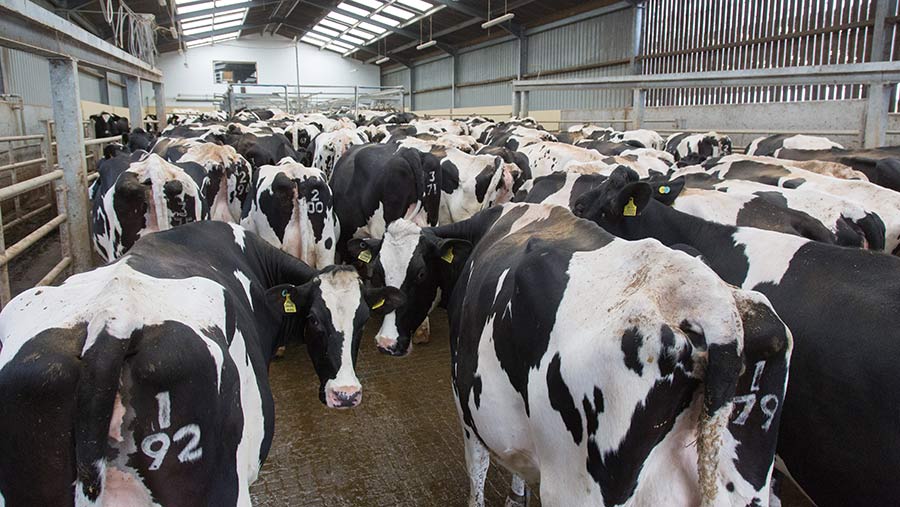Labour scarcity and costs to drive dairy decisions in 2022
 © Tim Scrivener
© Tim Scrivener The twin challenges of labour availability and cost, alongside higher feed, fuel and energy bills, are likely to drive structural change in the dairy sector next year.
While many have made decent profits over the past two to three years, depending on their milk contract terms, the rapid inflation of fuel and fertiliser costs will add 2p/litre to production costs next year, said Rob Hitch of Cumbria-based accountant Dodd & Co.
The need to pay more for labour as farming vacancies compete with an ever-growing range of alternative positions in other industries could add a further 1.5-2p/litre to costs – a significant rise, said Mr Hitch.
He puts current labour costs for housed herds at about 3.5p/litre and for grazing herds at about 5p/litre.
While the many recent milk price rises are welcome, much of that cash is likely to go to pay those higher fuel, fertiliser and labour bills.
Competitive labour market
“If the government is intent on driving up wages, we’re in a very competitive market,” said Mr Hitch.
“No one can get staff – farms are not on their own in that. If people can get £30,000 for a 40-hour week elsewhere, they won’t want to earn £30,000 for a 60- to 70-hour week on a dairy farm.
“Smaller farms can turn to robotics, but that’s very expensive on a large scale. There are some very big, very efficient farms that are reliant on employed staff – those that can manage them well and retain staff, offeringgood quality of life, will do well.”
While there is no impression among advisers that a significant exodus from dairy is about to happen, labour has been the topic of conversation, said auctioneer Sally Mitchell, a partner in Greenslade Taylor Hunt (GTH), which runs Sedgemoor Market in Somerset.
GTH has conducted sales of several herds of 300-plus head this year, which is unusual. “There has also been a move to a more extensive system by some, with big, strong, cross-bred cows in demand,” said Ms Mitchell.
The firm is talking to a few producers about dispersal sales next year, with TB playing a big part in timing. Once a farm has a clear test, there are just 60 days in which to hold a sale.
Investment driver
The need for investment can be the main reason behind a sale, with the decisions made easier if there are other options for the land and other resources, said Ms Mitchell.
At accountant Old Mill, partner Dan Heal said many are seriously considering a change to a less-intensive system or even moving out of dairy altogether.
For the many dairy units already being run efficiently, there are several options, he said.
Efficient operators have options
“Scaling back is the most relevant option for many, with many of the next generation seeing the challenges faced currently and not wanting to sign up to that lifestyle,” said Mr Heal.
“Cost inflation is also high on the agenda – budgets are crucial and it is important to look at margins.
“When buying fertiliser at high prices, the poorest-performing cows need to be able to make a return from the forage produced – these are the cows that would go in the event of a forage shortage. When looking at feed rates, remember it is the marginal litres that need to pay for this and not the overall feed per litre.”
Former dairy farmer Mark Yearsley of the Farm Consultancy Group also emphasised milk from forage as being key to reducing feed costs and improving efficiency. “Spending money on fertiliser will still be cheaper than buying extra feed.
“Producers do tend to follow tradition when applying nitrogen, so nutrient management plans are needed and should be followed,” he said.
“Bovine TB is also still having an effect on many dairy producers – losing productive animals means less milk in the tank and less money in the bank. Compensation does not cover the replacements, so this has a negative effect on cashflow.”
Mr Yearsley said the milk price needs to be about 40p/litre to cover the increase in costs, and give producers confidence to reinvest.
Dairy unit options to address labour issues
-
Scale back – both in livestock numbers and output, allowing a stretched team to manage more easily. With feed costs rising rapidly, it is not worth chasing marginal litres. The strength of the cull trade allows a stricter policy on removing the poorest performers.
-
Use more contractors – this relies heavily on contractors being available at the right time and reliable – the cost of poor silage is high.
-
Invest in infrastructure and technology – remove the need for some labour by making things easier. Robots are available for more jobs such as scraping and feed pushing. Stress test the required investments at 30p, 27p and 25p/litre and interest rates at 5%, 7% and 9% to make sure it stacks up financially.
-
Offer better packages to attract staff, increasing costs but allowing work to continue. Staff priorities have changed, with working hours and time off more desirable than increased pay. Rather than looking for staff to do a 60-hour week, it is more likely that two people would do 30 hours each.
Source: Dan Heal, Old Mill
